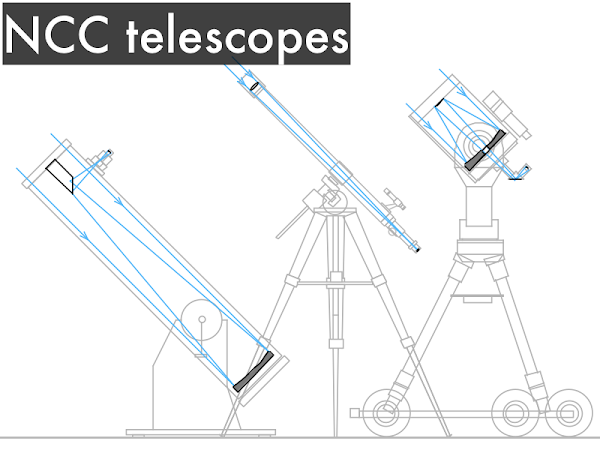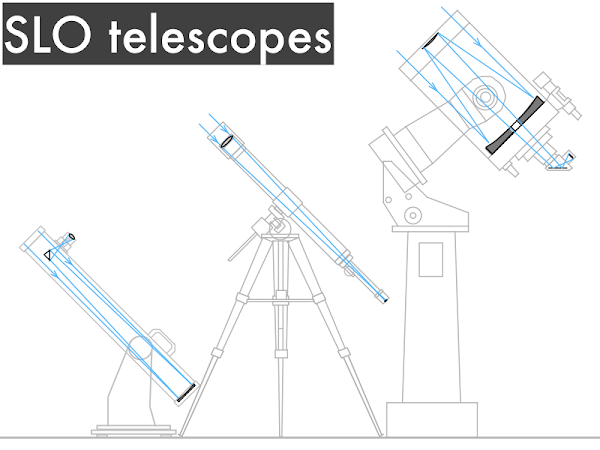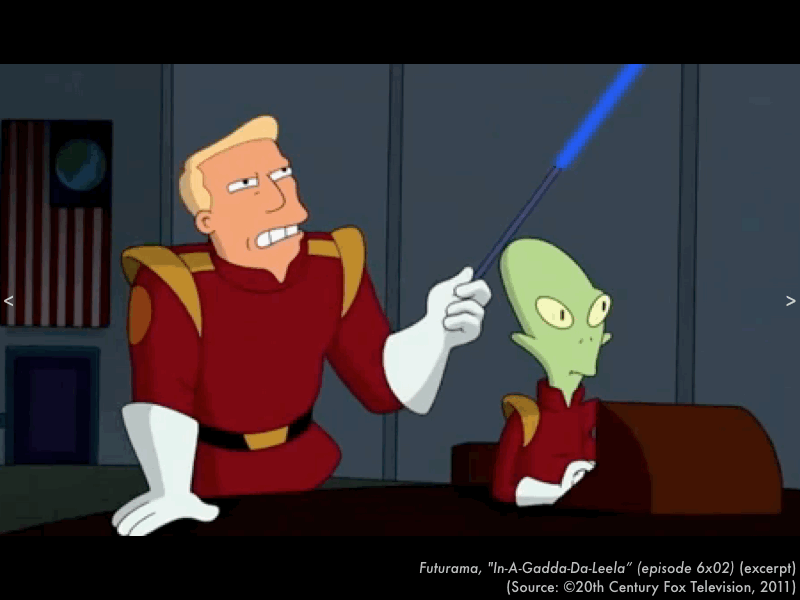 Ever consider buying a telescope, or least dreamt about one day owning one?
Ever consider buying a telescope, or least dreamt about one day owning one?After looking through a typical commercial telescope catalog, your eyes begin to glaze over as they all start looking the same. What makes one telescope better than another? What do you look for when you compare telescopes? (Video link: "110212-1220312.")
 We'll be looking at three powers that "rate" a telescope, and the factors that go into each of these three powers.
We'll be looking at three powers that "rate" a telescope, and the factors that go into each of these three powers.  Before we do all that, let's talk about three key parameters to measure or to look up when you take a look at a telescope.
Before we do all that, let's talk about three key parameters to measure or to look up when you take a look at a telescope.


 Let's consider three measurements that you will need to make or to look up for each of these telescopes--diameter D, primary focal length fprimary, and eyepiece focal length feyepiece.
Let's consider three measurements that you will need to make or to look up for each of these telescopes--diameter D, primary focal length fprimary, and eyepiece focal length feyepiece.  If the telescope has a lens in front, then it is a refractor, and you would need to measure the diameter of this lens (in cm).
If the telescope has a lens in front, then it is a refractor, and you would need to measure the diameter of this lens (in cm). If the telescope has a mirror in back (it may or many not have a glass plate in front), then it is a reflector, and you would need to measure the diameter of this mirror (in cm).
If the telescope has a mirror in back (it may or many not have a glass plate in front), then it is a reflector, and you would need to measure the diameter of this mirror (in cm).  The next measurement is the primary focal length fprimary of the lens, and if the telescope is a refractor is the distance (in cm) after the lens that the light will be brought to a focus. This is approximately the length of the tube.
The next measurement is the primary focal length fprimary of the lens, and if the telescope is a refractor is the distance (in cm) after the lens that the light will be brought to a focus. This is approximately the length of the tube. If the telescope is a refractor, then the primary focal length fprimary of the mirror is the distance (in cm) after the mirror that the light will be brought to a focus. This is approximately the either length of the tube, or twice the length of the tube, depending on the geometry of secondary mirrors within the telescope.
If the telescope is a refractor, then the primary focal length fprimary of the mirror is the distance (in cm) after the mirror that the light will be brought to a focus. This is approximately the either length of the tube, or twice the length of the tube, depending on the geometry of secondary mirrors within the telescope. The last measurement is the eyepiece focal length feyepiece, and is printed somewhere on the eyepiece itself (in mm).
The last measurement is the eyepiece focal length feyepiece, and is printed somewhere on the eyepiece itself (in mm). Now let's see how these three measurements are used to determine how powerful (or not) a telescope can be.
 First, light-gathering power, which allows a telescope to make faint images as bright as possible.
First, light-gathering power, which allows a telescope to make faint images as bright as possible.  Light-gathering power is how much light can be collected by a telescope, and more is better. This is simply related to the area of the primary lens or mirror, and a larger area will collect more light, making resulting images as bright as possible.
Light-gathering power is how much light can be collected by a telescope, and more is better. This is simply related to the area of the primary lens or mirror, and a larger area will collect more light, making resulting images as bright as possible.  The lens used in the Lick Observatory near San Jose, CA is 36" in diameter, and is close to the largest refracting lens ever made. Lenses like these are no longer typically made, even though they have large light-gathering powers, due to their weight and cost.
The lens used in the Lick Observatory near San Jose, CA is 36" in diameter, and is close to the largest refracting lens ever made. Lenses like these are no longer typically made, even though they have large light-gathering powers, due to their weight and cost. This is a large primary mirror used for the VISTA telescope in Chile, over four meters in diameter. Note that mirrors weigh less and are cheaper to manufacture than comparable-size refracting lens, so maximizing light-gathering power in modern astronomical research telescopes involves constructing large mirrors like this, rather than lenses.
This is a large primary mirror used for the VISTA telescope in Chile, over four meters in diameter. Note that mirrors weigh less and are cheaper to manufacture than comparable-size refracting lens, so maximizing light-gathering power in modern astronomical research telescopes involves constructing large mirrors like this, rather than lenses. Second, resolving power, which allows a telescope to make out fine details in its images.
Second, resolving power, which allows a telescope to make out fine details in its images. This can very crudely be considered a triangulation problem, so a large diameter lens or mirror will resolve small features.
This can very crudely be considered a triangulation problem, so a large diameter lens or mirror will resolve small features.  This is the Thirty-Meter Telescope that is currently planned for atop Mauna Kea, HI. Note that it achieves a large light-gathering power by virtue of the collectively large area of its mirror segments, and it also has a large resolving power from its large end-to-end diameter. This telescope is going to be awesome, but it is going to be very expensive.
This is the Thirty-Meter Telescope that is currently planned for atop Mauna Kea, HI. Note that it achieves a large light-gathering power by virtue of the collectively large area of its mirror segments, and it also has a large resolving power from its large end-to-end diameter. This telescope is going to be awesome, but it is going to be very expensive. There is a hack of sorts to maximize resolving power without having to maximize light-gathering power, if you want to look at the fine details of already very bright objects. This is an interferometer, where two small telescopes are spread out at a certain distance from each other. Spreading them out does not improve their collective light-gathering power, but it makes them behave as though they were two fragments of a much larger diameter mirror, which improves their resolving power. Yes, there is a lot of light "missing" from this "fragmented" mirror, but it is a cheap but effective way to maximize resolving power, given a limited amount of mirror area.
There is a hack of sorts to maximize resolving power without having to maximize light-gathering power, if you want to look at the fine details of already very bright objects. This is an interferometer, where two small telescopes are spread out at a certain distance from each other. Spreading them out does not improve their collective light-gathering power, but it makes them behave as though they were two fragments of a much larger diameter mirror, which improves their resolving power. Yes, there is a lot of light "missing" from this "fragmented" mirror, but it is a cheap but effective way to maximize resolving power, given a limited amount of mirror area. The "interference" of an interferometer is where the light collected simultaneously by both mirrors must be physically combined in real-time to a single image, so there is a practical limit to how far apart these telescopes can be placed. Here is the Keck Observatory atop Mauna Kea, HI, which was previously once the largest single reflector in the world, but now with a twin constructed next to it, can now improve its resolving power as well.
The "interference" of an interferometer is where the light collected simultaneously by both mirrors must be physically combined in real-time to a single image, so there is a practical limit to how far apart these telescopes can be placed. Here is the Keck Observatory atop Mauna Kea, HI, which was previously once the largest single reflector in the world, but now with a twin constructed next to it, can now improve its resolving power as well. Third, magnifying power, which makes an image as large as possible.
Third, magnifying power, which makes an image as large as possible.  But first, a clip on why of all the three telescope powers, magnifying power is the least important, behind resolving power, and light-gathering power, from an episode of Futurama (20th Century Fox Television, 2011).
But first, a clip on why of all the three telescope powers, magnifying power is the least important, behind resolving power, and light-gathering power, from an episode of Futurama (20th Century Fox Television, 2011). Zapp Brannigan: "Magnify that Death Sphere. [Image on screen zooms in on the Death Sphere.] Why is it still blurry?"So here (as usual) the writers on Futurama get the science right--light-gathering power and resolving power gets you images that are only so bright, and with so much detail. Magnification just enlarges the images after the fact, so you may just be getting larger pictures of dim, fuzzy images if there wasn't much light-gathering power and resolving power to begin with.
Kif Krocker: "It's all the resolution we have. Making it bigger doesn't make it clearer."
Zapp: "It does on CSI: Miami!"
Kif: (Sighs.)
 That said, if you have maximized your light-gathering power and resolving power (with a large diameter, or large effective diameter primary lens/mirror), then the magnification depends on the focal length or your primary lens or mirror, which we have seen is the distance after the lens or mirror that light will be brought to a focus. The magnifying power of a telescope is the primary focal length (some factor times the tube length) divided by the eyepiece focal length.
That said, if you have maximized your light-gathering power and resolving power (with a large diameter, or large effective diameter primary lens/mirror), then the magnification depends on the focal length or your primary lens or mirror, which we have seen is the distance after the lens or mirror that light will be brought to a focus. The magnifying power of a telescope is the primary focal length (some factor times the tube length) divided by the eyepiece focal length. Maximizing the magnifying power of a telescope is then a matter of having a primary lens or mirror with a long focal length...
Maximizing the magnifying power of a telescope is then a matter of having a primary lens or mirror with a long focal length... ...used with an eyepiece (here on the back of the Lick Observatory refractor) with a short focal length.
...used with an eyepiece (here on the back of the Lick Observatory refractor) with a short focal length. 


2 comments:
What do slo and ncc stand for?
SLO and NCC are the San Luis Obispo and North County Campus locations for Cuesta College.
Post a Comment